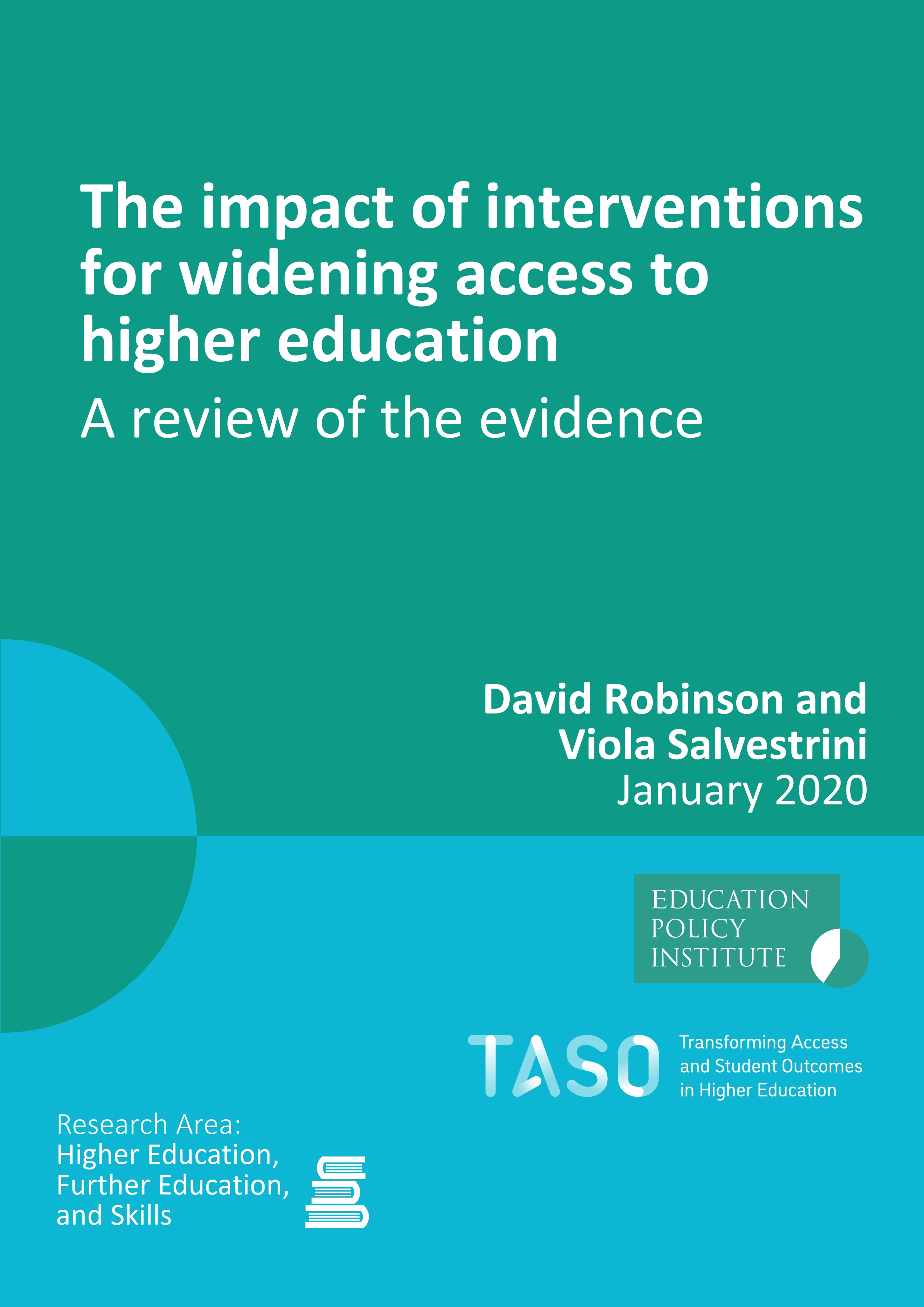The Education Policy Institute (EPI) has published new research on widening access to higher education for the most disadvantaged students, commissioned by the newly established Centre for Transforming Access and Student Outcomes in Higher Education (TASO).
While an increasing number of young people have progressed to higher education in recent years, the gap in access between poorer and more affluent students remains stark: students from the most affluent areas are more than twice as likely to enter higher education than those in the most deprived areas. For the most selective universities, they are six times more likely.
These large gaps persist despite significant investment from the higher education sector in activities to widen access over the last decade.
This detailed report analyses 92 studies that provide evidence of the impact of activities designed to boost the attendance of disadvantaged or underrepresented students. It sets out the gaps in the existing evidence base and outlines recommendations for future research.
Key findings from the new research include:
- The higher education sector has significantly increased activities to boost attendance of the most disadvantaged students, spending around £250m on programmes a year.
- Many activities are positively associated with disadvantaged students’ understanding of and attitudes towards higher education, as well as their life aspirations.
- However, there is an urgent need to go beyond student perceptions and establish the impact of these activities on enrolment numbers. Most research to date on widening access has failed to determine this.
- The government and HE sector should do more to monitor student progress and build a greater understanding of the impact of activities on disadvantaged school age pupils, as well as on groups such as mature students, carers, care leavers, some ethnic minority students and vocational students.
You can download the report here.
Findings in full
Which activities are effective in boosting access to higher education for disadvantaged students?
Student financial aid
- Providing financial aid to boost the attendance of the most disadvantaged is a high-cost intervention that typically generates a small but positive effect on enrolment in higher education. However, most existing studies measuring its impact have been conducted outside of the UK.
- Financial support is most successful when it is easy to understand for students. Increasing potential beneficiaries’ awareness of such support is also key to success.
Mentoring and counselling support
- Approaches that involve providing mentoring, counselling and role model services for students are positively associated with improving young people’s aspirations and understanding of what studying entails.
- However, there is little evidence on the effectiveness of such activities in generating increases in enrolments in higher education among the most disadvantaged.
Advice and guidance for students
- Light-touch interventions such as providing information, advice and guidance to students are low-cost, but research to date suggests that such activities have had a limited effect on both students’ aspirations and enrolment into higher education.
- Those that are successful tend to be tailored to the individual needs of students, start early in the student life cycle, and form part of existing careers advice in schools and colleges.
Summer schools
- Summer schools tend to be high-cost interventions, associated with improved student aspirations and higher education progression among participants.
- However, there is currently limited evidence of causality: it is possible that other factors may be leading to improved outcomes, beyond the summer schools.
Wider programmes with multiple elements of support
- Programmes that combine several different approaches to support students are the most evaluated intervention. Research suggests that they lead to considerable increases in student aspirations, and some increases in other outcomes. However, it is difficult to disentangle the individual components of these programmes.
- As these programmes are often expensive, isolating their different elements and improving our understanding of their impact is essential.
Addressing evidence gaps: report recommendations
- There is insufficient robust evidence on interventions that are likely to produce higher enrolment rates for disadvantaged students. This must be addressed urgently. While improved student aspirations are a positive development, the material effects of interventions on higher education take-up rates should be far better established.
- The most common and successful activities involve programmes for students with multiple components of support. Future research should isolate the separate elements of these programmes, to establish which are driving improved outcomes.
- There should be far greater focus on outcomes for overlooked, vulnerable groups, such as mature students, carers, ethnic minority students and vocational students.
- Further research should be conducted on the impact of student summer schools, to establish whether the programmes themselves are contributing directly to better outcomes.
- There is strong international evidence for the effectiveness of providing disadvantaged students with financial aid. However, more studies relevant to the UK context are needed.
- The government should do more to facilitate tracking the progress of students involved in widening participation programmes over time and between the school, college and higher education. This would improve our understanding of the impact of interventions on actual student enrolment numbers.
- Given that disadvantage gaps emerge early in people’s lives, and widen as they move through education, more research should be developed by the sector on approaches that could support disadvantaged students earlier in the student life cycle.
This report has been commissioned by the Centre for Transforming Access and Student Outcomes in Higher Education (TASO).
TASO is a new What Works Centre for the higher education sector, part of the Government’s What Works Movement. TASO’s focus will be on eliminating equality gaps in higher education within 20 years.
TASO is an independent hub for higher education professionals to access leading research, toolkits, evaluation techniques and more to help widen participation and improve equality within the sector.
TASO would like to thank everyone who contributed to this evidence review through our call for evidence, Theme Working Group and other deliberative mechanisms.



